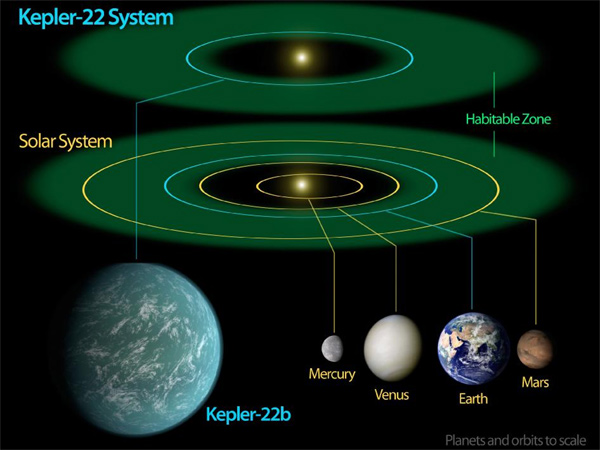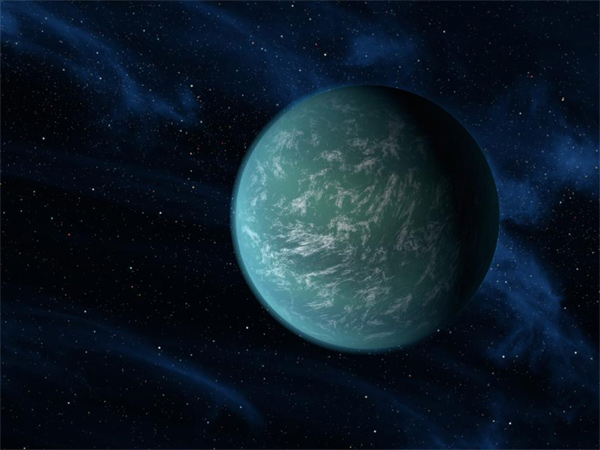Kepler 22b, a new habitable planet? ...
Sources
The discovery
NASA's Kepler mission has confirmed its first planet in the "habitable zone," the region where liquid water could exist on a planet’s surface. Kepler also has discovered more than 1,000 new planet candidates, nearly doubling its previously known count.Ten of these candidates are near-Earth-size and orbit in the habitable zone of their host star. Candidates require follow-up observations to verify they are actual planets.
The discovery was announced December 5, 2011. The planet was originally discovered on Kepler's third day of science operations in mid-2009. The third transit was detected in late 2010. Additional confirmation data was provided by the Spitzer Space Telescope and ground-based observations. The planet's radius is roughly 2.4 times the radius of Earth; it is 600 light years away from Earth, in orbit around the G-type star 1 Kepler 22, every 290 days.

Image credit : http://www.nasa.gov/mission_pages/kepler/multimedia/images/kepler-22b-diagram.html(NASA/Ames/JPL-Caltech)
"Those travelling proud on wooden boats never had once imagined that ships weighing thousands of tons of metal would once rule the mighty oceans... thus how does a mere 600 light years would matter in time?", *~ Anecentric
Composition
The newly confirmed planet, Kepler-22b, is the smallest yet found to orbit in the middle of the habitable zone of a star similar to our sun. The planet is about 2.4 times the radius of Earth. Scientists don't yet know if Kepler-22b has a predominantly rocky,gaseous or liquid composition, but its discovery is a step closer to finding Earth-like planets. To date, its mass and surface composition remain unknown. If it has an Earth-like density (5.515 g/cm3) then it would contain 13.8 Earth masses, while its surface gravity would be 2.4 times Earth's.If it has water-like density (1 g/cm3) then it would mass 2.5 Earths and have a surface gravity of 0.43 times Earth's. The planet may fall into the category of planets known as super-Earths, depending on what the actual mass is.

Image credit : http://www.nasa.gov/mission_pages/kepler/multimedia/images/kepler-22b.html (NASA/Ames/JPL-Caltech)
Possibility of life
Its near-surface temperature is presumed to be about 72 degrees Fahrenheit (22 Celsius). Scientists do not know, however, whether the planet is rocky, gaseous or liquid. Such planets have the right distance from their star to support water, plus a suitable temperature and atmosphere to support life.
Other destinations
NASA also announced that Kepler has uncovered 1,094 more potential planets, twice the number it previously had been tracking, according to research being presented at a conference in California this week. Kepler is NASA's first mission in search of Earth-like planets orbiting suns similar to ours, and cost the US space agency about $600 million. It is equipped with the largest camera ever sent into space -- a 95-megapixel array of charge-coupled devices -- and is expected to continue sending information back to Earth until at least November 2012. Kepler is searching for planets as small as Earth, including those orbiting stars in a warm, habitable zone where liquid water could exist on the surface of the planet. The latest confirmed exoplanet that could support life brings to three the total number confirmed by global astronomers. In addition to French astronomers' confirmed finding of Gliese 581d in May, Swiss astronomers reported in August that another planet, HD 85512 b, about 36 light years away seemed to be in the habitable zone of its star. A total of 48 exoplanets and exomoons are potential habitable candidates, among a total of 2,326 possibilities that Kepler has identified so far.
The top rankers are listed in an online catalog that indexes bodies outside our solar system, available online at http://phl.upr.edu.
Sources
Compiled by Sudip K Ghosh aka *~Anecentric
1. Please refer http://en.wikipedia.org/wiki/Stellar_classification#Class_G